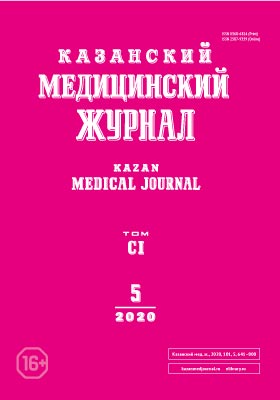Прогнозирование временной утраты трудоспособности в связи с заболеваниями органов кровообращения у работников предприятия жилищно-коммунального хозяйства
- Авторы: Бендюк Г.Я.1, Гришина Н.К.2, Дохов М.А.1,3, Сидоров А.А.1
-
Учреждения:
- Медико-санитарная часть ГУП «Водоканал Санкт-Петербурга»
- Национальный научно-исследовательский институт общественного здоровья им. Н.А. Семашко
- Санкт-Петербургский государственный педиатрический университет
- Выпуск: Том 101, № 5 (2020)
- Страницы: 734-739
- Раздел: Социальная гигиена и организация здравоохранения
- Статья получена: 02.07.2020
- Статья одобрена: 01.09.2020
- Статья опубликована: 27.10.2020
- URL: https://kazanmedjournal.ru/kazanmedj/article/view/34915
- DOI: https://doi.org/10.17816/KMJ2020-734
- ID: 34915
Цитировать
Аннотация
Цель. Разработать прогностическую модель возникновения временной утраты трудоспособности в связи с заболеваниями сердечно-сосудистой системы у работников предприятия жилищно-коммунального хозяйства на примере ГУП «Водоканал Санкт-Петербурга».
Методы. Исследование проводили на базе ведомственного амбулаторно-поликлинического учреждения — Медико-санитарной части ГУП «Водоканал Санкт-Петербурга» в 2015–2017 гг. За 3 года исследований под наблюдением находились 4634 человека. При изучении заболеваемости по данным проведённых периодических медицинских осмотров и заболеваемости с временной утратой трудоспособности рассчитывали экстенсивные показатели, свидетельствующие о структуре заболеваемости, и интенсивные показатели, характеризующие распространённость патологического процесса. Прогнозирование заболеваемости с временной утратой трудоспособности проводили с помощью метода последовательного анализа А. Вальда в модификации Е.В. Гублера и нейросетевой модели.
Результаты. Установлено, что на основании данных оперативного статистического учёта медико-санитарной части с помощью нейронной сети, опираясь на линейные и нелинейные зависимости коморбидной заболеваемости, в частности болезнями органов дыхания, можно правильно (в 92,4% случаев) прогнозировать случаи временной утраты трудоспоспобности в связи с заболеваниями сердечно-сосудистой системы у работников предприятия жилищно-коммунального хозяйства ГУП «Водоканал Санкт-Петербурга». Высокие чувствительность (97,7%) и специфичность (90,7%) метода позволяют использовать его для прогноза потребности в лечебно-профилактических мероприятиях прикреплённого к медико-санитарной части контингента.
Вывод. Разработанная модель позволила определить основные направления профилактической работы для снижения заболеваемости патологией системы кровообращения с временной утратой трудоспособности: профилактика повышенного артериального давления и заболеваний органов дыхания.
Полный текст
Об авторах
Григорий Яковлевич Бендюк
Медико-санитарная часть ГУП «Водоканал Санкт-Петербурга»
Email: mad20@mail.ru
Россия, г. Санкт-Петербург, Россия
Наталья Константиновна Гришина
Национальный научно-исследовательский институт общественного здоровья им. Н.А. Семашко
Email: mad20@mail.ru
Россия, г. Москва, Россия
Михаил Александрович Дохов
Медико-санитарная часть ГУП «Водоканал Санкт-Петербурга»; Санкт-Петербургский государственный педиатрический университет
Автор, ответственный за переписку.
Email: mad20@mail.ru
Россия, г. Санкт-Петербург, Россия; г. Санкт-Петербург, Россия
Александр Анатольевич Сидоров
Медико-санитарная часть ГУП «Водоканал Санкт-Петербурга»
Email: mad20@mail.ru
Россия, г. Санкт-Петербург, Россия
Список литературы
- Белялов Ф.И. Проблема коморбидности при заболеваниях внутренних органов. Вестн. соврем. клин. мед. 2010; 3 (2): 44–47.
- Самородская И.В., Никифорова М.А. Терминология и методы оценки влияния коморбидности на прогноз и исходы лечения. Бюлл. НЦССХ им. А.Н. Бакулева РАМН. 2013; 14 (4): 18–26.
- Эфрос Л.А., Наумова О.А., Жданова Е.А., Андриенко С.В. Клинические аспекты и подходы к оценке выраженности коморбидности у больных с острым коронарным синдромом. Уральский мед. ж. 2018; (10): 81–89. doi: 10.25694/URMJ.2018.10.26.
- Бойцов С.А., Деев А.Д., Шальнова С.А. Смертность и факторы риска развития неинфекционных заболеваний в России: особенности, динамика, прогноз. Терап. архив. 2017; (1): 5–14. doi: 10.17116/terarkh20178915-13.
- Бойцов С.А., Шальнова С.А., Деев А.Д. Эпидемиологическая ситуация как фактор, определяющий стратегию действий по снижению смертности в Российской Федерации. Терап. архив. 2020; (1): 4–9. doi: 10.26442/00403660.2020.01.000510.
- Ракитский В.Н., Липатова Л.В., Измайлова О.А. Профилактика сердечно-сосудистых заболеваний у работников предприятий горнодобывающей промышленности. Здравоохр. РФ. 2016; (1): 10–12. doi: 10.18821/0044-197X-2016-60-1-10-12.
- Каримова Л.К., Гимаева З.Ф., Галимова Р.Р. Оценка кардиоваскулярного риска у работников нефтехимических производств и разработка программы профилактики сердечно-сосудистых заболеваний. Гигиена и санитария. 2019; 98 (9): 978–983. doi: 10.18821/0016-9900-2019-98-9-978-983.
- Аверьянова Т.А., Труфанова Н.Л., Потеряева Е.Л. Оценка эффективности использования технологий профилактики и оздоровления медицинских работников в крупной медицинской организации. Journal of Siberian Medical Sciences. 2012; (5): 4.
- Пырикова Н.В., Осипова И.В., Концевая А.В. Клинико-экономическая эффективность организационной модели первичной профилактики сердечно-сосудистых заболеваний у работников железнодорожного транспорта. Рос. кардиол. ж. 2014; (6): 12–18. doi: 10.15829/1560-4071-2014-6-12-18.
- Суворова Е.И., Шальнова С.А., Концевая А.В. Ассоциация использования ресурсов системы здравоохранения и временной нетрудоспособности с факторами риска хронических неинфекционных заболеваний в Российской Федерации по данным популяционного исследования. Рационал. фармакотерап. в кардиол. 2018; 14: 70–76. doi: 10.20996/1819-6446-2018-14-1-70-76.
- Пырикова Н.В., Концевая А.В., Осипова И.В. Клинико-экономический анализ реализации первичной профилактики сердечно-сосудистых заболеваний в организованном коллективе. Бюлл. мед. науки. 2018; (4): 60–66.
- Белялов Ф.И. Прогнозирование заболеваний с помощью шкал. Комплексные проблемы сердечно-сосудистых заболеваний. 2018; 7 (1): 84–93. doi: 10.17802/2306-1278-2018-7-1-84-93.
- Петри А., Сэбин К. Наглядная медицинская статистика. М.: ГЭОТАР-Медиа. 2015; 216 с.
- Гублер Е.В. Информатика в патологии, клинической медицине и педиатрии. Ленинград: Медицина. 1990; 176 с.
- Галушкин А.И. Нейронные сети: основы теории. М.: Горячая линия — Телеком. 2017; 496 с.
- Бендюк Г.Я., Дохов М.А., Сидоров А.А. Анализ патологической поражённости работников крупного предприятия жилищно-коммунального хозяйства по результатам периодических медицинских осмотров. Казанский мед. ж. 2019; (4): 695–700. doi: 10.17816/KMJ2019-695.
- Захарова Р.Р., Калимуллина Г.Н., Романов В.С. Условия труда и состояние здоровья работников нефтеперерабатывающих предприятий. Медицина труда и экология человека. 2015; (4): 120–122.
- Беспалова А.В., Кононенко Т.В. Тенденции заболеваемости с временной утратой трудоспособности железнодорожников, работающих на станции Февральск. Вестн. обществ. здоровья и здравоохр. Дальнего Востока России. 2017; (4): 5–14.
- Вёрткин А.Л., Скотников А.С. Коморбидность. Леч. врач. 2013; (8): 78–81.
- Наумова Л.А., Осипова О.Н. Коморбидность: механизмы патогенеза, клиническое значение. Соврем. пробл. науки и образования. 2016; (5): 105–119.
Дополнительные файлы







